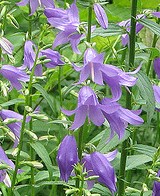
Native to China, this herbaceous perennial is a member of the bellflower family, Companulaceae, that also includes lobelia and balloon flower. The plants grow 2-2.5′ tall and have fleshy roots and upright branched stems. The basal leaves are kidney shaped while the stem leaves are narrowly ovate to elliptic, 1.5-3″ long, and have finely toothed margins. In late spring to summer loose racemes of fragrant, bell-shaped flowers appear that are 3/4″ long and deep blue. Common ladybell is attractive grouped in the border or in a woodland garden and is especially valued for its relative heat tolerance. Because of its deep fleshy roots the plants are best left undisturbed. The genus name, Adenophora, comes from Greek words aden meaning gland and phoro meaning bear, referring to the sticky nectary around the base of the style. The specific epithet, confusa, is the Latin word meaning uncertain and perhaps refers to its resemblance to bellflowers.
Type: Herbaceous perennial
Bloom: Loose racemes of bell-shaped bue flowers in summer
Size: 1-1.5′ H x 1′ W
Light: Full sun to partial shade
Soil: Average, medium moist, well-drained
Hardiness: Zones 3-9
Care: Low maintenance
Pests and Diseases: Generally healthy but snails and slugs can damage leaves.
Propagation: Seed, division
Companion Plants: Lady’s mantle, Siberian iris, Japanese, forest grass
Outstanding Selections: Fairybells ‘Gaudi Violet’ (long bloom time, dense racemes)